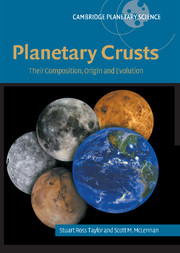Book contents
- Frontmatter
- Contents
- Preface
- Acknowledgments
- List of abbreviations
- Prologue
- 1 The planets: their formation and differentiation
- 2 A primary crust: the highland crust of the Moon
- 3 A secondary crust: the lunar maria
- 4 Mercury
- 5 Mars: early differentiation and planetary composition
- 6 Mars: crustal composition and evolution
- 7 Venus: a twin planet to Earth?
- 8 The oceanic crust of the Earth
- 9 The Hadean crust of the Earth
- 10 The Archean crust of the Earth
- 11 The Post-Archean continental crust
- 12 Composition and evolution of the continental crust
- 13 Crusts on minor bodies
- 14 Reflections: the elusive patterns of planetary crusts
- Indexes
- References
10 - The Archean crust of the Earth
Published online by Cambridge University Press: 22 October 2009
- Frontmatter
- Contents
- Preface
- Acknowledgments
- List of abbreviations
- Prologue
- 1 The planets: their formation and differentiation
- 2 A primary crust: the highland crust of the Moon
- 3 A secondary crust: the lunar maria
- 4 Mercury
- 5 Mars: early differentiation and planetary composition
- 6 Mars: crustal composition and evolution
- 7 Venus: a twin planet to Earth?
- 8 The oceanic crust of the Earth
- 9 The Hadean crust of the Earth
- 10 The Archean crust of the Earth
- 11 The Post-Archean continental crust
- 12 Composition and evolution of the continental crust
- 13 Crusts on minor bodies
- 14 Reflections: the elusive patterns of planetary crusts
- Indexes
- References
Summary
That dark backward and abysm of time
(William Shakespeare)The Archean
More so than most of the past, the Archean is truly another country, with a geological record that is distinct from that of more recent epochs. The Archean covers a crucial 1500 Myr of Earth history, nearly three times the length of the entire Phanerozoic, from the earliest recorded rocks at its beginning to the growth of 60–70% of the continental crust by its close.
Much confusion has arisen through the imprecise use of the term Archean, or even Precambrian, in referring to the “Archean crust”. Thus the “Precambrian” includes two totally distinct periods of Earth history that are separated by the great transition between the Archean and Proterozoic. Although the Archean has been formally divided into the following eras: Eoarchean (3800?–3600 Myr), Paleoarchean (3600–3200 Myr), Mesoarchean (3200–2800 Myr) and Neoarchean (2800–2500 Myr) it will be interesting to see if this classification is widely adopted. However, we are less concerned here with the details of the tectonic evolution of the Archean terrains to which this scheme might be applicable, so that we use the somewhat broader and commonly employed subdivision of that epoch into Early (3.9–3.5 Gyr), Middle (3.5–3.0 Gyr) and Late Archean (3.0–2.5 Gyr).
Yet even within the Archean, there is a vast difference between the scattered remnants that remain of the earliest crust, preserved at locations such as Isua in Greenland and the massive cratons in Canada, Australia, Africa and elsewhere, that developed in the Late Archean over a billion years later.
Information
- Type
- Chapter
- Information
- Planetary CrustsTheir Composition, Origin and Evolution, pp. 249 - 274Publisher: Cambridge University PressPrint publication year: 2008
